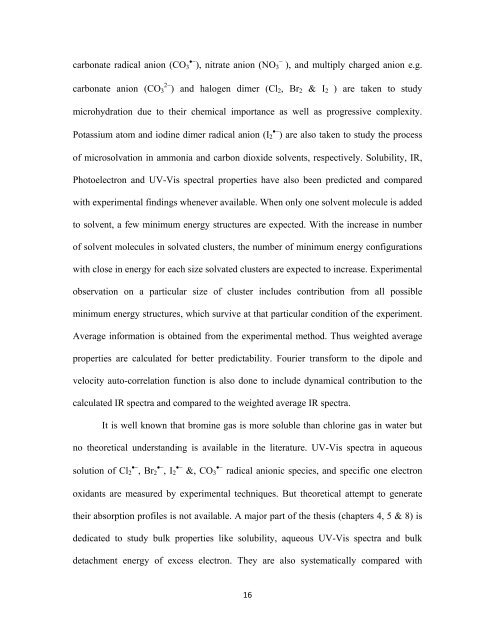CHEM01200604005 A. K. Pathak - Homi Bhabha National Institute
CHEM01200604005 A. K. Pathak - Homi Bhabha National Institute
CHEM01200604005 A. K. Pathak - Homi Bhabha National Institute
You also want an ePaper? Increase the reach of your titles
YUMPU automatically turns print PDFs into web optimized ePapers that Google loves.
carbonate radical anion (CO 3 •− ), nitrate anion (NO 3<br />
−<br />
), and multiply charged anion e.g.<br />
carbonate anion (CO 3 2− ) and halogen dimer (Cl 2 , Br 2 & I 2<br />
) are taken to study<br />
microhydration due to their chemical importance as well as progressive complexity.<br />
Potassium atom and iodine dimer radical anion (I •− 2 ) are also taken to study the process<br />
of microsolvation in ammonia and carbon dioxide solvents, respectively. Solubility, IR,<br />
Photoelectron and UV-Vis spectral properties have also been predicted and compared<br />
with experimental findings whenever available. When only one solvent molecule is added<br />
to solvent, a few minimum energy structures are expected. With the increase in number<br />
of solvent molecules in solvated clusters, the number of minimum energy configurations<br />
with close in energy for each size solvated clusters are expected to increase. Experimental<br />
observation on a particular size of cluster includes contribution from all possible<br />
minimum energy structures, which survive at that particular condition of the experiment.<br />
Average information is obtained from the experimental method. Thus weighted average<br />
properties are calculated for better predictability. Fourier transform to the dipole and<br />
velocity auto-correlation function is also done to include dynamical contribution to the<br />
calculated IR spectra and compared to the weighted average IR spectra.<br />
It is well known that bromine gas is more soluble than chlorine gas in water but<br />
no theoretical understanding is available in the literature. UV-Vis spectra in aqueous<br />
solution of Cl •− 2 , Br •− 2 , I •− 2 &, CO •− 3 radical anionic species, and specific one electron<br />
oxidants are measured by experimental techniques. But theoretical attempt to generate<br />
their absorption profiles is not available. A major part of the thesis (chapters 4, 5 & 8) is<br />
dedicated to study bulk properties like solubility, aqueous UV-Vis spectra and bulk<br />
detachment energy of excess electron. They are also systematically compared with<br />
16
















